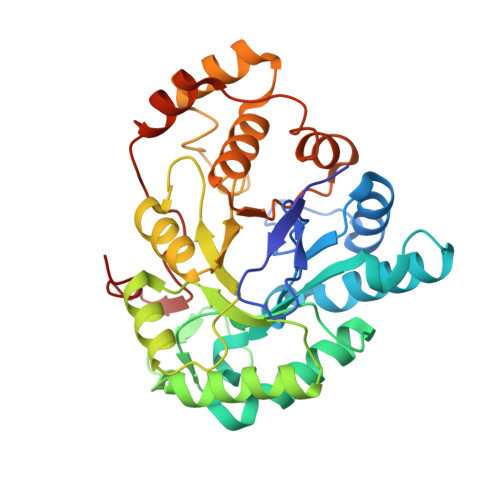Structural elucidation of chalcone reductase and implications for deoxychalcone biosynthesis
Bomati, E.K., Austin, M.B., Bowman, M.E., Dixon, R.A., Noel, J.P.(2005) J Biological Chem 280: 30496-30503
- PubMed: 15970585
- DOI: https://doi.org/10.1074/jbc.M502239200
- Primary Citation of Related Structures:
1ZGD - PubMed Abstract:
4,2',4',6'-Tetrahydroxychalcone (chalcone) and 4,2',4'-trihydroxychalcone (deoxychalcone) serve as precursors of ecologically important flavonoids and isoflavonoids. Deoxychalcone formation depends on chalcone synthase and chalcone reductase; however, the identity of the chalcone reductase substrate out of the possible substrates formed during the multistep reaction catalyzed by chalcone synthase remains experimentally elusive. We report here the three-dimensional structure of alfalfa chalcone reductase bound to the NADP+ cofactor and propose the identity and binding mode of its substrate, namely the non-aromatized coumaryl-trione intermediate of the chalcone synthase-catalyzed cyclization of the fully extended coumaryl-tetraketide thioester intermediate. In the absence of a ternary complex, the quality of the refined NADP+-bound chalcone reductase structure serves as a template for computer-assisted docking to evaluate the likelihood of possible substrates. Interestingly, chalcone reductase adopts the three-dimensional structure of the aldo/keto reductase superfamily. The aldo/keto reductase fold is structurally distinct from all known ketoreductases of fatty acid biosynthesis, which instead belong to the short-chain dehydrogenase/reductase superfamily. The results presented here provide structural support for convergent functional evolution of these two ketoreductases that share similar roles in the biosynthesis of fatty acids/polyketides. In addition, the chalcone reductase structure represents the first protein structure of a member of the aldo/ketoreductase 4 family. Therefore, the chalcone reductase structure serves as a template for the homology modeling of other aldo/keto-reductase 4 family members, including the reductase involved in morphine biosynthesis, namely codeinone reductase.
- Jack Skirball Chemical Biology and Proteomics Laboratory, Salk Institute for Biological Studies, La Jolla, California 92037, USA
Organizational Affiliation:

















